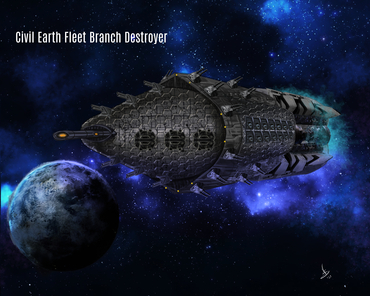Civil Earth Fleet Branch Destroyer

| Vessel type | Destroyer class |
| Society | Civil Earth |
| Size | 1706.88 meters /5600 feet |
| Tonnage | 22.5 million metric tons |
| Propulsion and power | Tilli super drive sublight thrusters, faster than light drive, powered by three fusion core reactors |
| Crew | 3800 |
| Troop transport size | 13,000 |
Destroyer class vessels are the hallmark of all Free Worlds military forces in occupied space. They’re used for offensive and defensive maneuvers as well as troop transportation. Destroyers have an array of flexibility to deploy for multiple types of engagements needed by commanding officers. Of all the classifications of military-grade vessels, destroyers rank among the highest, only being matched by flagships and heavy carriers when paired against each other. Dolrinion war barges might have a slight edge over destroyers, but it’s never been tested in a controlled setting.
Destroyers are not able to enter a planet’s atmosphere and operate solely in the vacuum of space.
Weapons systems
Main Batteries: 165 double slide cannons. The main weapons fire standard armor-piercing shells that weigh over 3.45 metric tons/7605 pounds and are loaded by automated feeders. The tubes can fire every 15 seconds.
Secondary batteries: 1000 single bore cannons spread throughout the length of the ship. Automatic feeders ensure continuous fire. Defensive flak walls and exploding debris rounds are the greatest protection for Free Worlds ships.
Point defense weapons: Primary weapon used to destroy incoming fire that penetrates flak walls. Standard PDF (point defense fire) is a 6-centimeter projectile using kinetic force to destroy incoming bombardment. These weapon systems can fire 18,000 rounds per minute, and in close quarters battle can be used to fire directly on enemy ships. A destroyer class has 600 of these systems spaced out throughout the outer hull.
Uranium spinners: Tertiary offensive and defensive weapons system that shoots 7,500 rounds per minute. Shells are 11-centimeter heavy mass uranium core penetrators. 50 of these advanced systems come equipped on a CE destroyer.
Missile/Torpedo tubes: 32 tubes located forward, mid and rear. Weapons canisters contain fusion and high explosive rockets.
Auto super rail: Is a one-of-a-kind direct targeting autofire high yield railgun for distance bombardment located on the forward nose of all Fleet Branch destroyers. These platforms can devastate an enemy vessel from extreme ranges and terrorize planets but require excessive amounts of power to deploy. Fleet Branch strategies for using this weapon would keep three destroyers at the rear of any fleet to engage their rails while other vessels provide cover and keep primary fleets engaged. Colonial Navy commanders/planners answered the challenge of auto super rails by creating their missile starships. Destroyers engaging one on one aren’t able to utilize this weapon due to its power requirements.
Command deck / Command and Control / Bridge / Operations center
Like most transport ships throughout occupied space, warships keep their critical areas at the vessel’s core protected by endless layers of metal composites to shield them from assault. Warship control centers will continue to operate and issue directives even as the ship depressurizes and breaks apart. Vessels owned by wealthy individuals or entities will have a core or saferoom made from Corin steel which is extremely rare.
Technology
The Free Worlds of Humanity have all reached a high point of technological evolution that still pales by comparison to Titan technology. Each has rebuilt fusion reactors, a technology from the Old World, and retrofitted existing faster than light jump drives to suit current needs. Glitches are still present through Free Worlds computer calculations when plotting jumps through occupied space. Misjumps, reverse jumps, hook jumps and stop jumps occur on occasion, which sometimes proves fatal. Free Worlds engineers and scientists continue to try and intertwine basic Old World technologies with the most advanced hardware available to current systems. This is a primary reason for the delayed buffering issue when moving through a rip in space during an FTL jump.